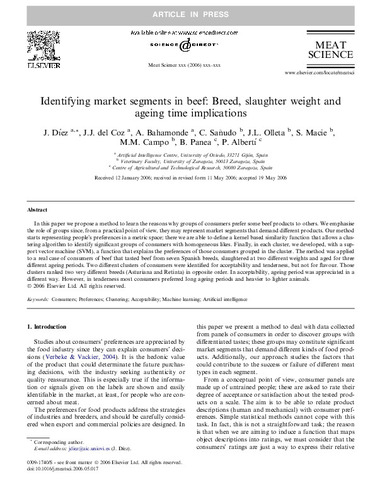Identifying market segments in beef: Breed, slaughter weight and ageing time implications
Palabra(s) clave:
Consumers preferences
Clustering
Machine learning
Artificial intelligence
Fecha de publicación:
Editorial:
Elsevier
Versión del editor:
Citación:
Descripción física:
Resumen:
In this paper we propose a method to learn the reasons why groups of consumers prefer some beef products to others. We emphasise the role of groups since, from a practical point of view, they may represent market segments that demand different products. Our method starts representing people’s preferences in a metric space; there we are able to define a kernel based similarity function that allows a clustering algorithm to identify significant groups of consumers with homogeneous likes. Finally, in each cluster, we developed, with a support vector machine (SVM), a function that explains the preferences of those consumers grouped in the cluster. The method was applied to a real case of consumers of beef that tasted beef from seven Spanish breeds, slaughtered at two different weights and aged for three different ageing periods. Two different clusters of consumers were identified for acceptability and tenderness, but not for flavour. Those clusters ranked two very different breeds (Asturiana and Retinta) in opposite order. In acceptability, ageing period was appreciated in a different way. However, in tenderness most consumers preferred long ageing periods and heavier to lighter animals
In this paper we propose a method to learn the reasons why groups of consumers prefer some beef products to others. We emphasise the role of groups since, from a practical point of view, they may represent market segments that demand different products. Our method starts representing people’s preferences in a metric space; there we are able to define a kernel based similarity function that allows a clustering algorithm to identify significant groups of consumers with homogeneous likes. Finally, in each cluster, we developed, with a support vector machine (SVM), a function that explains the preferences of those consumers grouped in the cluster. The method was applied to a real case of consumers of beef that tasted beef from seven Spanish breeds, slaughtered at two different weights and aged for three different ageing periods. Two different clusters of consumers were identified for acceptability and tenderness, but not for flavour. Those clusters ranked two very different breeds (Asturiana and Retinta) in opposite order. In acceptability, ageing period was appreciated in a different way. However, in tenderness most consumers preferred long ageing periods and heavier to lighter animals
ISSN:
Colecciones
- Artículos [37548]
- Informática [875]
Ficheros en el ítem




